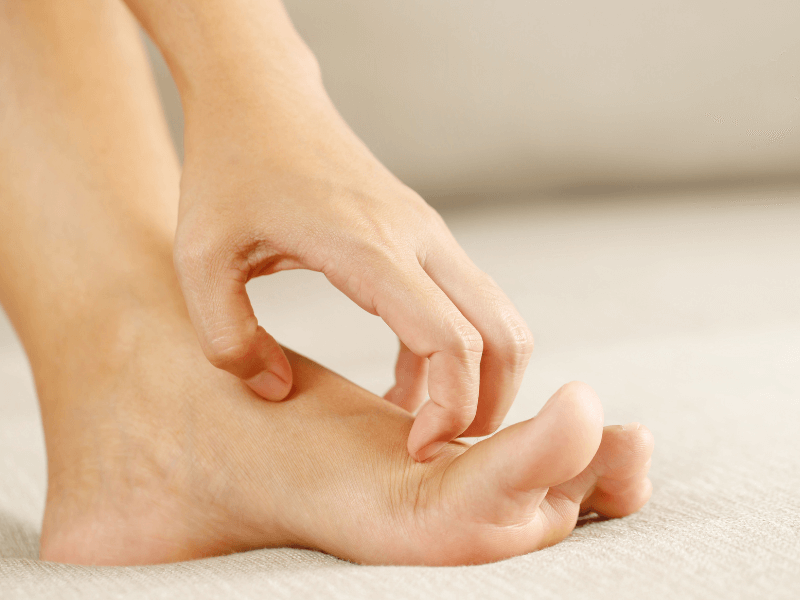It’s often said that itchy feet are a sign you’re about to go on an adventure – but in reality, persistent itchiness is usually caused by a foot condition that needs attention. If ignored, it can quickly become uncomfortable, irritating, or even painful.
When you scratch an itch, your body releases serotonin – a chemical that actually intensifies the itching sensation. This can create a “scratch–itch cycle,” where scratching provides short-term relief but worsens the problem and may break the skin, increasing the risk of infection.
To find real relief, it’s important to identify and treat the underlying cause of your itchy feet rather than just the symptom.
1. Athlete’s Foot (Tinea Pedis)
One of the most common causes of itchy feet is athlete’s foot, a contagious fungal infection.The National Library of Medicine states that around 15% to 25% of people are likely to have athlete’s foot at any one time.
Typical symptoms include:
- Persistent itchiness between the toes or on the soles
- Red, inflamed, or scaly skin
- Cracking or peeling skin, sometimes with a burning sensation
Because the fungus thrives in warm, moist environments (like inside shoes), the condition often worsens without treatment. Scratching can spread the infection to your hands or other areas of the body.
What to do:
- Keep your feet clean and thoroughly dry, especially between the toes.
- Change socks daily and wear breathable footwear.
- Use an antifungal cream or spray, as advised by your podiatrist.
- Disinfect shoes regularly and avoid walking barefoot in communal areas like gyms or swimming pools.
For stubborn cases, your podiatrist may recommend a stronger topical treatment or oral antifungal medication.
2. Dry Skin (Xerosis)
If your feet feel rough, flaky, or tight – and you notice an irritating itch – dry skin may be the culprit. The feet naturally have fewer oil glands, which means they can easily become dehydrated, especially during colder months or after frequent washing.
Left untreated, dry skin can crack and peel, leading to painful fissures and an increased risk of infection.
What to do:
- Apply a urea-based foot cream daily to deeply hydrate the skin and lock in moisture.
- Avoid harsh soaps that strip away natural oils.
- Exfoliate gently once a week to remove dead skin.
- Stay hydrated and wear cotton socks to allow your skin to breathe.
If your dryness doesn’t improve or you notice peeling between the toes, see your podiatrist to rule out fungal infection or eczema. You can book an appointment at one of our five Feet By Pody clinics in London for expert care and lasting relief.
3. Chilblains
If you notice red, itchy, swollen patches on your toes after exposure to cold weather, you may have chilblains – a condition caused by sudden changes in temperature. When cold feet warm up too quickly, small blood vessels can’t adapt fast enough, leading to inflammation and irritation.
Scratching chilblains can break the skin, causing painful sores that are prone to infection.
What to do:
- Warm your feet slowly – avoid direct heat or hot water.
- Keep feet dry, warm, and protected with wool socks and well-fitting shoes.
- Apply soothing calamine lotion or witch hazel to reduce irritation.
- If symptoms don’t improve within a few weeks or look infected, see your podiatrist for professional treatment.
Your podiatry clinic can help prevent recurrent chilblains with circulation advice, skincare recommendations, and regular foot checks.
4. Sunburn
In summer, feet are often forgotten when it comes to sun protection – but sunburned feet can become sore, red, and incredibly itchy as the skin heals. In more severe cases, people experience “hell’s itch” – an intense, crawling sensation that feels like being bitten by insects.
What to do:
- Apply aloe vera or calamine lotion to soothe the skin.
- Use cool compresses to ease inflammation.
- Avoid popping blisters or peeling skin.
- Take oral antihistamines for severe itching or burning sensations.
- Always apply broad-spectrum SPF 30+ sunscreen to your feet before going barefoot or wearing sandals.
If your sunburned skin becomes swollen, blistered, or infected, contact your podiatrist for assessment.
5. Diabetic Neuropathy
For those with diabetes, itchy feet can sometimes indicate diabetic neuropathy – a type of nerve damage caused by high blood sugar levels. Damaged nerve fibres can cause tingling, burning, or itching sensations in the feet.
Because neuropathy reduces sensation, you might not feel injuries, blisters, or infections developing – which can lead to serious complications if untreated.
What to do:
- If you have diabetes, schedule regular diabetic foot assessments.
- Manage blood sugar levels carefully with the support of your GP or diabetes nurse.
- Inspect your feet daily for cuts, blisters, or colour changes.
- Keep feet clean and moisturised to maintain skin integrity.
Early diagnosis and professional foot care can significantly reduce complications and improve comfort.
When to See a Podiatrist for Itchy Feet
Occasional itchy feet are common, but if the itch persists, spreads, or causes visible skin changes, it’s time to see a podiatrist. Persistent itching can indicate infection, circulation issues, or skin conditions that need medical attention.
At Feet By Pody, our experienced London podiatrists can identify the cause of your itchy feet, provide targeted treatment, and help you prevent recurrence through expert foot care advice.
Book your appointment online or call 0207 099 6657 to restore comfort and keep your feet healthy all year round.

